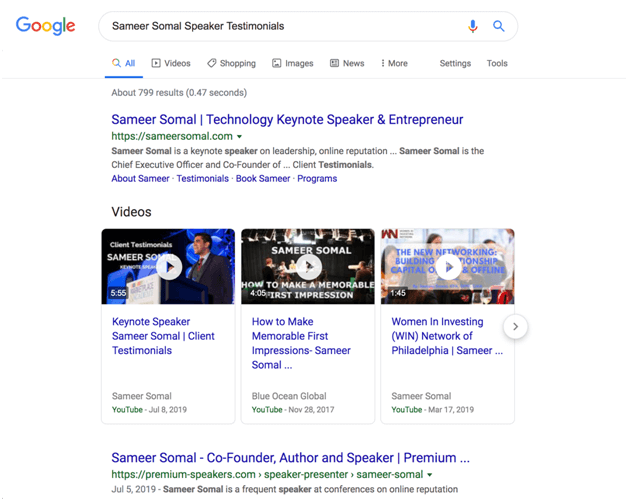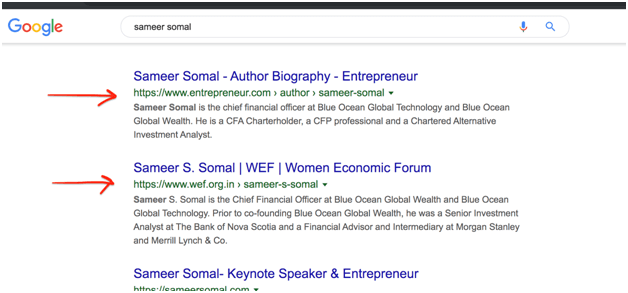Before anybody does business with you, they’d have Googled your name. The links and information that appear on the first few pages of Google when your name is searched for are what potential partners perceive you are. That’s why online reputation management is key.
According to Eric Schmidt, “Identity will be the most valuable commodity for citizens of the future and it will exist primarily online.”
Curating a positive online reputation is no longer optional. Successful online reputation management (ORM) and search engine optimization (SEO) companies help their clients achieve results through proactively coordinating content, websites, and search engine results pages (SERPs).
In this article, I will share how the right SEO-driven content strategy will boost your digital reputation.
Why online reputation is important to your business’ existence
1. Consumers trust user-generated content more
Research by TurnTo revealed that 99% of consumers would consider user-generated content before making a purchase decision. At Blue Ocean Global Tech, we consistently receive emails from executives, entrepreneurs, and lawyers who have realized too late how one comment or negative link adversely impacts their revenue and bottom line.
2. Your online reputation affects your business offline too
Yes, this is important. Prospective patrons research a restaurant before walking into the physical venue to experience the real thing. According to BrightLocal consumer survey research, 82% of consumers read online reviews for a local business before booking an appointment.
3. Talents will only work with a business that has a great reputation
Businesses may view their online reputation from a customer-acquisition standpoint. However, digital presence affects almost everything, including the perception of potential employees.
How to augment your online reputation by building on SEO efforts
1. Optimize content for a successful ORM campaign
People are influenced by what they read about you. This is where it is necessary to ensure positive content ranks higher for your names or brand keywords.
What is the difference between SEO and ORM, then? Since highlighting your positive content alone does not guarantee that your potential customers or partners will see the most representative information, you need effective SEO to rank and feature the strengths of your brand. Consistently publishing content without implementing effective SEO tactics is a common practice, which we refer to as “spray and pray”.
Keep in mind that the most successful reputation management campaigns rank specific articles, videos, blogs, and websites that highlight your expertise.
An effective SEO strategy will accomplish the following areas:
- Optimize pages of your website to appear atop of SERPs and rank for target keyword phrases.
- Feature your genuine social profiles representing your company or brand name.
- Optimize company-hosted and third-party review website pages to populate when an interested person Googles “your brand name + reviews.”
- Influence search engines to highlight positive content and simultaneously push negative or irrelevant content down beyond the third or fourth page.
2. How to optimize content for better discovery on the internet
2a. Types of content to optimize for optimal results
What type of content is best optimized for optimal results? Authentic and concise writing attracts back-links from credible websites. Naturally, optimizing these digital assets insulates you from defamatory content and suppresses negative or erroneous links. Below are several examples of concentrated SEO content.
- A guide or tutorial article: Guides are content that takes the reader through the process of understanding a subject. Guides may be harder to create but will rank higher for keyphrases over time. They earn backlinks easily.
- Video review of your product/company/industry: According to a study by Forrester Research, video is 50 times more likely to achieve organic page rank in Google than plain text. With video content, you can easily rank positive content for targeted phrases. Additionally, the best offense is a strong defense. Authentic video digital assets inoculate your brand against future malicious or defamatory posts, whether anonymous or not.

- Whitepapers: Releasing an original-content white paper is a widely accepted strategy for positively impacting search results. Similar to an actionable guide, the white paper can offer in-depth forecasts and developed arguments, which will further establish you as a reputable authority.
- Website bearing your name with a press page: If you do not already have a website bearing your name, now is the time you should create one. Nourish this cornerstone digital asset with SEO-rich content about yourself and your brand. Begin with the end in mind so that you eventually rank on multiple keywords organically. Even if someone wants to do business with Blue Ocean Global Technology, whether through a referral, email outreach, or direct phone call from me, they often Google “Sameer Somal” because I am the CEO. Investing the time to create SameerSomal.com pays ongoing dividends in credibility and trust. Prospects and new friends often thank me for that website because they were able to read so much about me in one place.
- An author page or brand page on an authority publication: Publications and sites such as Wikipedia, Forbes, Entrepreneur, and Inc.com often rank on page one for your name in search results. Individuals can have author bylines in Inc.com while companies can be listed on the Inc. 5000 list. Since these high-domain-authority websites allow you to have a biography of yourself on your author page, they are compelling options for concentrated SEO content.

2b. Scores to target for achieving higher content discovery
Connect your goals with the creation of authoritative SEO content to best support your online reputation management campaign. While originating SEO-rich content will rank favorably with Google, consider these benchmarks to drive measurable results:
- Aim for depth: You want your content to be as in-depth as possible, giving your readers all the necessary summary information they would want on a single page. Supplement the main points with detailed content that includes technical details and action steps for implementation. Google’s algorithm will understand the depth and subsequently rank the comprehensive material higher for target keywords.
- Link to credible sources: With in-depth content, you will notice that you’re making claims that would need to be backed by sources. More so, when you’re attempting to win readers over to your side, ensure your facts and data are referenced from credible sources.
- Break your content into digestible formats: You do not want your content to be skimmed over and abandoned because it is difficult to read. Aside from the fact that in-depth SEO content would help you dominate search results, it’s an opportunity to have all of your positive sides ingrained in the minds of your readers, helping you to earn their trust once more.
3. Where brands should focus on when optimizing content for reputation enhancement
To ensure your content performs well, make sure you’re publishing them on high-authority websites. This goes for both visual and text-based content.
For the content hosted on your personal or company website, ensure that all of your website properties are optimized and maintained and update plug-ins monthly. SEO and reputation campaigns will yield relatively marginal results if users are driven back to a website that is not functional or responsive. Furthermore, foundational opportunities to rank on Google and reach people who want your help are missed when you don’t perform regular technical maintenance on your website.
After optimizing your website to perform highly in search results, you should also level up your reputation campaign and promote best-performing content. The next step is to identify positive pillar content sources.
3a. Identifying positive content – Best practices
You want to make sure you’re not only creating rich SEO-driven content but are actually putting your optimal effort into promoting the type of content that highlights your strengths. To identify positive content that may benefit your brand image, consider these milestones you may overlook:
- Received congratulatory wishes when they were released – Such as completing a successful acquisition, receiving an award, reaching a new industry milestone, getting featured in an important publication, and so on.
- Celebrated the fulfillment of a personal goal – Such as hitting a weight-loss goal, completing a book you’ve been working on, hiring that star employee you’ve always dreamed of working with, and others.
- Documented a partnership goal – Has your brand always dreamed of working with another brand, and have you always talked openly about this? Such content could augment your brand’s reputational image by investing SEO efforts into it.
- Documented the process it took to achieve a huge goal – Completing your major office headquarters or complex would fall into this category, as would the content that documents the process it took to develop your flagship product from scratch to finish.
4. How to use image search ranking to augment online reputation efforts
Images are often ignored in ORM efforts by marketers because it’s assumed that it is difficult to rank images. Images still provide many opportunities to claim your branded keywords, create authentic back-links, and build a strong reputation within search engines.
Consider this: Why is it that most of the time, when you run a query of a famous person’s name in Google, images of them usually rank at the top of the results? And images often dominate the Knowledge Graph area for popular names such as celebrities, brands, or popular destinations.
Below are some techniques for using images to dominate search results for your online reputation repair campaign.
4a. Optimize alt tags and keywords
Alt tags in images are strings of connected texts that help search engine crawlers to understand what an image is about. When adding images to your content, always include your branded keywords in the alt text area of the images. For the most effective results, keep the texts connected to each other by adding the underscore sign “_” after every string of text. So, say I was to add an image of myself in content, I’d add the following text to the alt text area: “Sameer_Somal_CEO_of_Blue_Ocean_Global_Tech”, instead of just including random text or just barely adding my name to it.
4b. Name the image after the branded keywords
If you’re uploading an image to your website as a part of your SEO content, you’ll be missing out on keyword ranking opportunity if you’re saving such images with random texts, or, in some scenarios, with numbers. Instead, use the branded keywords you want to rank for as the name of the images. This means you’d have to locate the image file destination on your local storage—that is, your computer or hard drive – and change the name of the image to the branded keyword you want it to rank for. Again, you can use the alt tags approach to optimize it by linking the texts together.

Conclusion
The ORM process helps aligns your sales, marketing, and technology efforts. SEO content is a key pillar for achieving the results you seek on the internet. By learning the top-performing SEO strategies to rank atop search results for your branded keywords, you’ll be able to maintain a clean image on the internet and create opportunities.
Sameer Somal is the Co-Founder and CEO of Blue Ocean Global Technology, a global leader in online reputation management. He is a recognized international keynote speaker and an internet defamation subject matter expert witness. Sameer can be reached on LinkedIn.
The post The role of SEO in online reputation management (ORM) appeared first on Search Engine Watch.
from SEO – Search Engine Watch https://ift.tt/2sd7hVs
via IFTTT

No comments:
Post a Comment